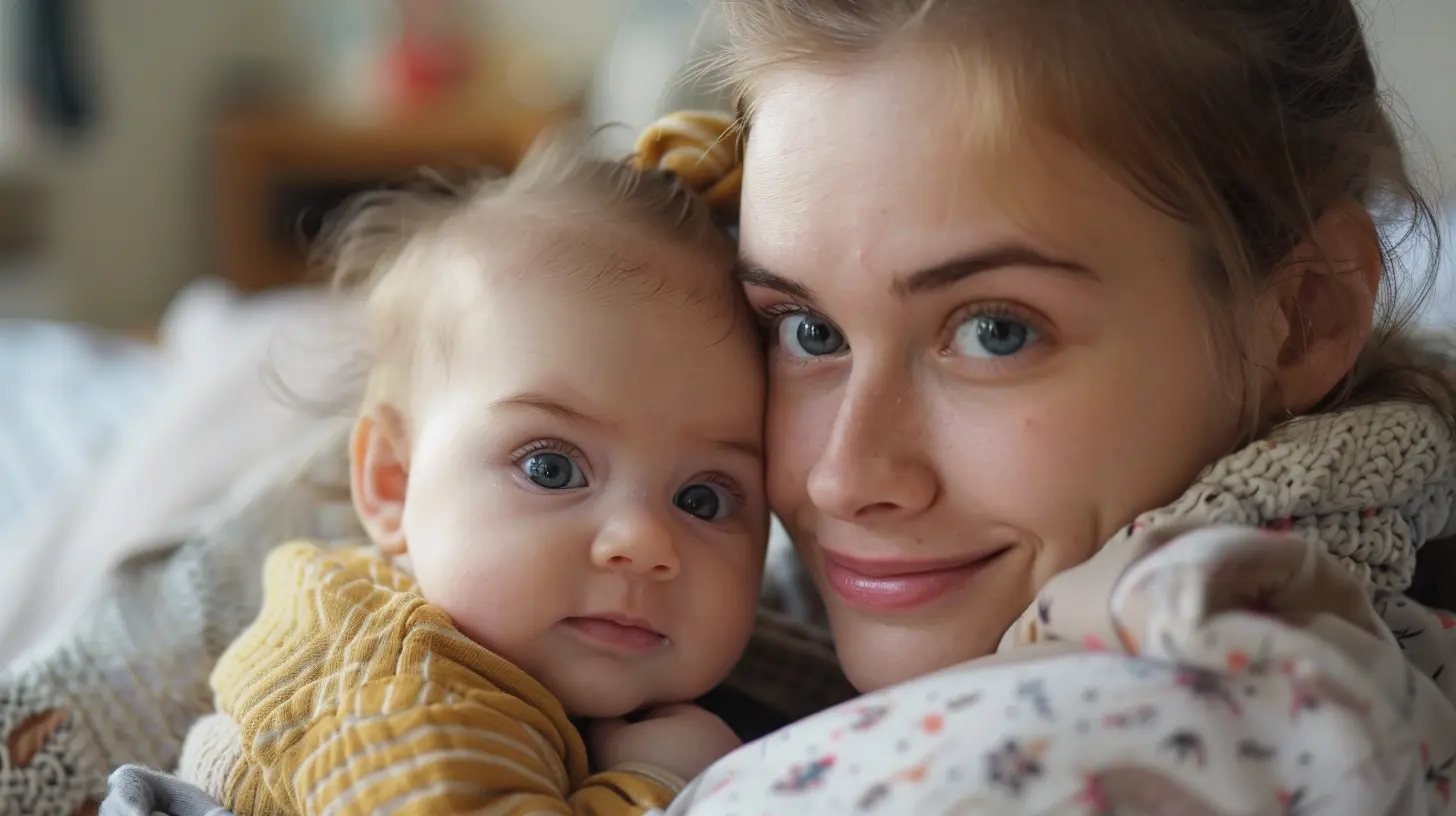How to Introduce Sleep Training When Your Child is Sick or Teething
17 August 2025
Ah, sleep training—the ever-elusive holy grail of parenting. Just when you think you’ve got your bedtime routine nailed down, your little one wakes up with the sniffles or starts gnawing on everything in sight like a teething beaver. Sound familiar?
If you're wondering how on earth you're supposed to sleep train a baby who's sick or cutting their first tooth, you're not alone. The good news? It’s possible—with patience, empathy, and a LOT of coffee (for you, not the baby, obviously).
In this guide, we're diving into the nitty-gritty of how to introduce sleep training during those chaotic times when your child's not feeling their best. So grab your favorite mug, and let's talk about sleep, snotty noses, and survival.
Why Sleep Training During Illness or Teething Feels Impossible
Let’s be honest—nothing derails your baby’s sleep faster than a runny nose or sore gums. And it makes sense! Imagine trying to fall asleep when you feel like there's a tiny construction crew jackhammering your gums or you can't breathe properly.It’s no different for babies. Their discomfort naturally makes them crankier, clingier, and much less likely to settle themselves to sleep.
So yes, trying to teach a baby to self-soothe when they’re under the weather feels like attempting to bake a soufflé during an earthquake. But here's the thing—you don't have to put all sleep training on hold. There are ways to work around the rough patches.
First, Know When to Hit Pause
Let’s get one thing out of the way: if your child has a fever, ear infection, or a particularly nasty cold, now might not be the best time to start full-on sleep training.Why? Because when your little one’s body is fighting something off, they actually need more comfort and closeness. They aren’t being manipulative—they genuinely need you.
Signs to Pause Sleep Training:
- Persistent high fever
- Very restless sleep or constant crying
- Trouble feeding (which could impact hydration and energy)
- Unusual lethargy or irritability
- Diagnosed illness (like the flu, RSV, ear infections, etc.)
If these are in play, it’s okay to hit the brakes on training. Think of it as a detour—not a derailment.
What About Teething?
Teething is tricky because it can last for months (seriously, months). So if you wait until all the teeth are in, you could be waiting until preschool.But here’s the truth—most teething discomfort is temporary and comes in waves. The key is figuring out whether your baby is in the peak of discomfort or if it’s just mild irritation.
How to tell it’s peak teething time:
- Swollen, red gums
- Excessive drooling
- Biting or gnawing everything
- Refusing to eat
- Fussiness that’s worse at night
If it’s a particularly bad night, offer comfort and wait it out. But if the symptoms are manageable, there’s no harm in gently continuing sleep training efforts.
The Gentle Approach: Adjusting Expectations
Look, sleep training isn't an all-or-nothing game. When your baby’s sick or teething, you don’t have to go full Ferber or cry-it-out. Instead, aim for consistency with flexibility.Here’s how:
1. Stick to the Routine (As Much As You Can)
Kids thrive on routines. They’re like tiny CEOs who love knowing what comes next. During illness or teething, the bedtime routine becomes even more crucial because it’s familiar and comforting.Keep the basics:
- Bath
- Story or song
- Milk
- Snuggles
- Bedtime
Even if they’re fussy, continuing the routine signals that it's time to wind down. It keeps your long-term sleep goals intact without forcing the issue.
2. Offer Extra Comfort—But Set Boundaries
Don’t beat yourself up for rocking your baby to sleep when they’re sick. You’re not undoing weeks worth of work. Comfort is needed.But try not to add new habits you’ll regret later. For instance:
- Rocking them to sleep? Okay.
- Bringing them into your bed for a week? Understandable.
- Starting a new pacifier habit at 11 months? Maybe not ideal.
Do what feels right in the moment, but think, “Will Future Me be cool maintaining this?”
3. Tweak the Sleep Method If Needed
If you’ve been doing a ‘gradual retreat’ method or ‘check-ins,’ you can stick with it—just go slower.For example:
- If check-ins were every 5 minutes, now do every 2-3 minutes the first night of illness.
- If you leave the room after 10 seconds, maybe you stay for a lullaby first.
Slow and steady keeps the sleep foundation alive.
When Your Baby Wakes More Often
Night wakings are often the biggest challenge during sickness or teething. Just when you thought you’d earned your full night's sleep badge—bam! Back to 2 a.m. wakeups.Here’s how to handle it like a sleep ninja:
- Respond promptly — Sick babies may genuinely need you. Go in, check on them, offer comfort.
- Keep lights low and interaction minimal — Think “ninja mode.” Calm, quiet, no chit-chat. You're not starting a party at 2 a.m.
- Offer relief if needed — Teething gel (if pediatrician-approved), baby-safe pain reliever, suctioning noses, etc.
- Re-settle them in their crib — Even if they're waking, try to keep their sleep space consistent.
Get Help From Your Pediatrician
You’re not in this alone! If your baby is waking excessively, rejecting feedings, or seems uncomfortable no matter what you do, it’s okay to call your pediatrician.They can:
- Rule out an ear infection (those are sleep killers)
- Suggest safe teething remedies
- Reassure you that what you’re doing is right
Sometimes, all you need is a little backup to feel better about your sleep training choices.
The Comeback Plan: Getting Back on Track
Once your baby’s feeling better (hallelujah), it’s time to return to your sleep training goals. Here’s how to bounce back:1. Reinstate the Routine
Go back to your full bedtime routine like clockwork. Even if your baby protests, repetition brings comfort.2. Be Confident (Even If You're Faking It)
Babies can smell hesitation. (Okay, not literally—but they do pick up on your vibes.) If you’re confident about bedtime, they’re more likely to follow your lead.3. Reset Boundaries Kindly
If you started rocking them to sleep again, begin phasing it out. Try putting them down drowsy but awake. They might resist at first, but they’ll remember the drill.4. Get Back to the Method You Were Following
Whether it was Ferber, Chair Method, or something else—resume your plan. The brief detour isn’t a setback. You’re picking up right where you left off.Real Talk: You’re Doing Great
Listen, parenting isn’t a perfect science. Some nights your kid will sleep peacefully, and some nights you’ll be Googling “Can a baby survive without sleep because mine might be a vampire?”It’s okay.
Sleep training isn’t about perfection. It’s about helping your baby (and you!) get the rest you need in a way that fits your life. If that means pausing during a cold or modifying during teething, so be it.
What matters most isn’t the method—it’s the love, consistency, and grace you bring into the process.
Even in the chaos, you’re laying the foundation for healthy sleep habits in the long run.
So give yourself a break, pour another cup of tea (or wine—we won’t judge), and remember—you’ve got this.
Tips Cheat Sheet: Sleep Training During Illness or Teething
| Situation | What to Do ||-----------|------------|
| Child has fever or infection | Pause sleep training. Comfort and monitor. Resume when better. |
| Mild teething | Stick with existing routines. Offer extra cuddles but don’t introduce new habits. |
| More night wakings | Respond calmly. Keep it dark and boring. Be consistent. |
| Sleep regression hits | Don’t panic. Recommit to routine and boundaries once they’re well. |
| Method no longer works | Adjust the method slightly. Go slower. Use more presence. Reassess if needed. |
Final Thoughts
Introducing sleep training when your child is sick or teething is like trying to put together IKEA furniture with missing screws—doable, but you’ll need creativity, patience, and maybe a few deep breaths.Some nights will be rough. But others will surprise you. And over time, your baby will learn to sleep through those disruptions with your loving guidance.
Parenthood is messy, unpredictable, and full of curveballs—but your instincts, paired with a solid sleep plan, are a powerhouse combo.
You’ve totally got this.
all images in this post were generated using AI tools
Category:
Sleep TrainingAuthor:

Maya Underwood
Discussion
rate this article
1 comments
Zephyrwind Malone
Introducing sleep training during illness or teething requires sensitivity. Prioritize comfort and establish a gentle routine. Consider temporary adjustments while maintaining foundational sleep habits, ensuring your child feels secure. Patience and flexibility are key during this challenging phase.
September 4, 2025 at 2:22 AM

Maya Underwood
Thank you for your insightful comment! Sensitivity, comfort, and flexibility are indeed crucial when introducing sleep training during these challenging times.


